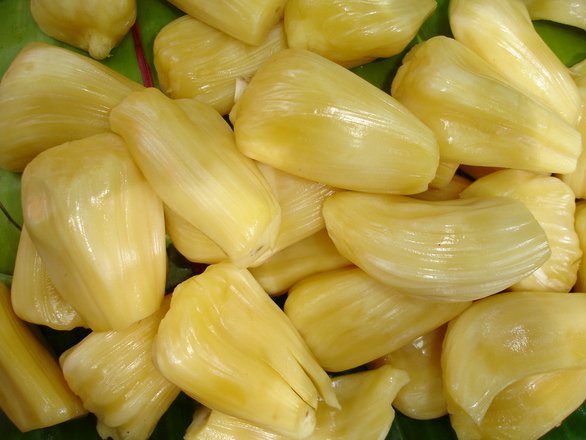Artocarpus heterophyllus, jackfruit, jakfruit, aca, nangka, is in the moraceae family, along with Breadfruit (Artocarpus altilis), Breadnut (A. altilis 'Seminifera'), Champedak (A. integer), Lakoocha (A. lakoocha) and Marang (A. odoratissimus).

The tree originates in India, but spread throughout Asia and into South America early on. Today it's found in Australia and the US as well.

Hardiness is only to about 27 F, but even that will kill off smaller branches. Young trees can't handle sub-freezing temperatures, so should be covered on colder nights.
The tree can grow to be quite massive, sometimes compared to the majestic eastern oak of the US. However, in areas where it's stressed by cold, such as in the US, its size will be greatly reduced.

If you decide to try to grow these, either grow from seed where you want them or plan on transplanting as soon as or before four leaves form. Because they have an aggressive taproot, you don't want to wait any longer. Air layering has been very successful and cuttings have seen some success.
The fruit is just plain awesome looking. The skin is a little pliable, but has spines all over it. They're not too sharp, but sharp enough to hurt if pressed hard or suddenly.
One thing that you'll see in this video is that the flies were super interested. Maybe it's because they're so aromatic, I don't know. I was really excited to try this one, as may be evident in the video. And I wasn't disappointed. Here's the video... plus my dog's first taste.
The fruit is green to yellowish and the exterior flexible when ripe. Before opening, it emits an odd odor akin to cooked onions. But the open fruit smells wonderful, sort of like pineapple and mango.
From the California Rare Fruit Growers:
Immature fruit is boiled, fried, or roasted. Chunks are cooked in lightly salted water until tender and then served. The only handicap is copious gummy latex which accumulates on utensils and hands unless they are first rubbed with cooking oil. The seeds can also be boiled or roasted and eaten similar to chestnuts. In Southeast Asia dried slices of unripe jackfruit are sold in the markets. The ripe bulbs, fermented and then distilled, produce a potent liquor.


I recorded my video right before recording me eating one of @papa-pepper's hot peppers. While not quite the same, he tried this wonderful fruit too and recorded his experience. Check it out!


I found this GIF on GIPHY that seems to be a recipe for sauteed jackfruit. It didn't come with any instructions other than what you see in the sequence. :)
@papa-pepper also pointed out that the seeds can be roasted, sort of like chestnuts, so I looked it up. It turns out that it's very simple. You can boil them in water for 10-15 minutes, bake them at 400 F for 20 minutes or coock them on medium/high heat in a cast iron skillet. When you can easily stick a fork in 'em, they're ready. Just remove the shell and enjoy.
As we check out these different fruits, some are great, some are moderate and some may merely offer some nutritional or medicinal value. Regardless, it's fun to try them and experience each one. In the case of jackfruit, I can't recommend it enough. It's not my favorite, but high on the list. And it's versatility is great. Something really cool is that just one of these could offer a wonderful fruit tasting experience for a large group of people, especially if cut up and seeds roasted prior.
The price should be under $1 a pound. If you see one, pick it up. You surely won't regret it.
Steemin' on,


Logo courtesy of @oecp85



